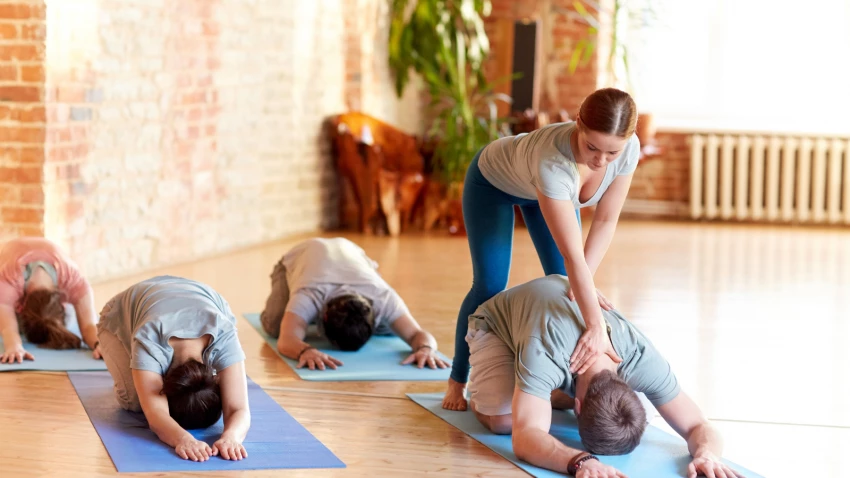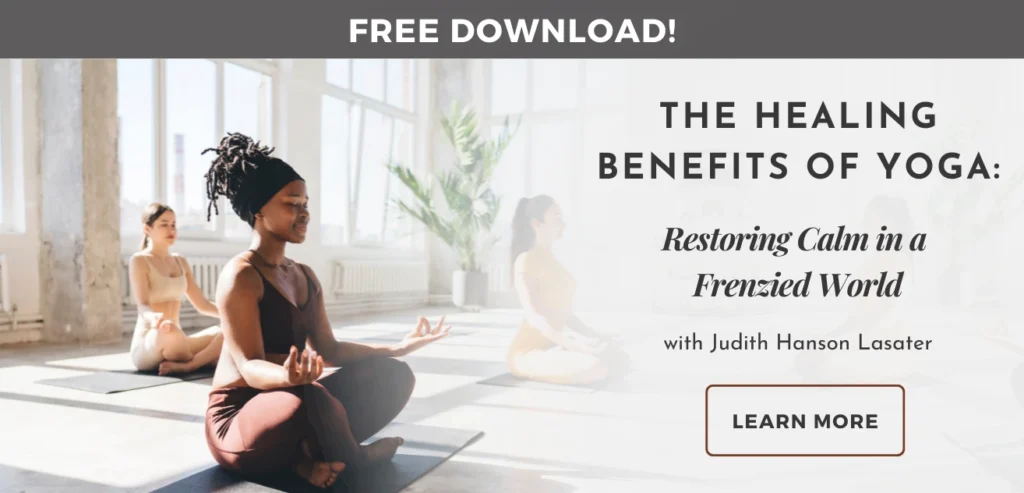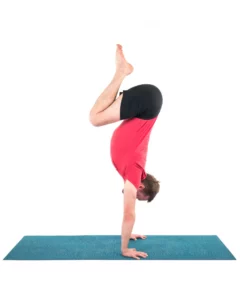Yoga Teachers: Are You Practicing With Your Students?

As a yoga teacher, I’m constantly looking for more tools to add to my teaching repertoire, because each student learns differently. Cues, visual demonstrations, and prop setups aren’t universal. Visual demonstrations, which can come in the form of demos or practicing alongside students (or a mixture of both), clearly convey what is being asked physically of the student. One of the questions that I typically get from newer yoga teachers is whether or not they should practice with their students. It’s an interesting question worth exploring.
I would define practicing with students as moving through the entire practice, speaking while moving. This is much different from a yoga demo. Demoing a pose or a short sequence involves stopping the class, so that students can observe your movements.
Teaching Yoga Students: Practicing with Your students
Is there anything wrong with practicing with your students?
There are pros and cons. Practicing with your students can cultivate a “we are in this together” type of atmosphere. The class mood tends to be more relaxed because students don’t feel as if you’re watching them. Having a teacher’s eyes on you the entire class can be intense—even if that’s not the intent. (That’s different from observing how they move in order to better instruct them.) You may also feel something in your own body that ignites a sensory cue at the moment that you may not have discovered otherwise.

The downside to practicing with your students is that it can stunt your teaching growth. By walking around and observing, you can see if your verbal cueing is effective. You will see your students respond, or not. This teaches you to adjust your cue when something isn’t working, or save it in your teaching bank when it does. Observing your classes helps you see your students’ progress in real-time and gives you the opportunity to help struggling students. You can also praise and acknowledge your students and their accomplishments.
Overall, I would lean away from practicing alongside students. As a teacher, you will learn and grow more if you observe instead. This will provide you with an abundance of tools to support and teach your students.
So, I Can’t Practice With My Students at All?
There is definitely a gray area with practicing alongside your students. This gray area falls under settings, learning preference, and safety. At yoga studios, students are more conditioned to adhere to verbal cueing and physical adjustments. In fitness arenas like gyms, the students are used to working out with their teacher, including their yoga teacher.
The culture of the setting where you’re teaching might dictate a tendency to practice with students. Can this be broken? Yes. Incrementally and through conversation, you can communicate to your students that you will be walking around to better serve them. You still might practice along 90 percent of the time. But little by little, your verbal cueing will get stronger. And students will learn that they can start listening to their body’s movements rather than basing their movements on those of their teacher.
Without a doubt, there are visual learners. Practicing alongside those learners can go a long way in helping them grow. Also, if it’s difficult to hear the instructor, the visual transcends the auditory. In these types of circumstances, you can practice alongside for the first side or first round. Then you can walk around, observe, cue based on your observations, and assist when your students practice the second side.
Safety Considerations—Physical and Emotional
Safety is another huge and fascinating issue. If you are practicing with your class, you most likely aren’t seeing the whole class the entire time. And you want to be able to see your whole class the entire time. If you are practicing deep or complex poses, and you aren’t watching your students, you might miss a preventable misalignment.
As an example, perhaps everyone is in a standing forward bend and a student decides to lift up into Headstand Pose (Sirsasana) and subsequently takes down the students in front of them. You might not have been able to stop the event, but at least you will be able to see what happened, describe it, and alert students to the danger to themselves and others that such behavior might entail.
The Importance of Seeing your students
Being able to see your students at all times is crucial. In the right circumstances, you can still give your students the visual cue of practicing while looking at them. Think of teaching Tree Pose (Vrksasana). You are facing them, they can see your movements, and safety is not compromised. Generally in gyms, the teacher has access to a mirror, so they can use it as a tool to watch their students while in positions where it would be impossible to do so otherwise.
You might also consider the emotional safety of students. Some students feel safer when the teacher is practicing on their mat and not observing their movements. When a teacher is practicing as well, students can have the emotional space to freely move and experience their bodies without anyone interfering. If they know the teacher won’t walk around while observing or assisting them, this can create an emotionally safe experience for the student.
I had an experience with a studio a few years ago where the owners asked me to practice with students as I taught because the students didn’t feel comfortable as I was walking around. At that time, I felt there was only one way to teach, which was to observe intensely. Over time, I’ve eased that position as I’ve learned that students come to the mat for a variety of reasons outside of learning how to do a pose. As a teacher, my path had to become more inclusive of not just the material I was presenting, but also to embrace the needs of students on a greater scale.
What’s the Right Way to Teach?

There isn’t a right way to teach, but there are certain factors that we need to consider. Being clear when you want your students to stop and watch you, and also being open to practicing while teaching in a safe way, can benefit your students by teaching them something specific, while also allowing them to move their bodies in a way where they don’t feel watched or judged.
Your teaching style will forge its own path and will become informed by your students’ learning styles, your preferences for holding space for your students, and the teaching environment you want to cultivate. We can make a case for and against practicing with students. As you learn and grow, your teaching path will become clearer and easier to navigate.
Also, read...
Teaching Yoga: The Wisdom of Not Knowing
Nov 19 – Charlotte Bell
Icicles and Gratitude
Nov 12 – By: Lana Reed
How to Overcome the 4 Most Common Yoga Teacher Challenges: The Power of Niche Building
Oct 11 – Eva Norlyk Smith, Ph.D.
Related courses

Allison Ray Jeraci, E-RYT 500, RPYT, is a vinyasa-based yoga teacher, fascinated by the intricate relationship between the mind and body. She offers a range of alignment-focused classes touching on anatomy, philosophy, and creative propping with a mindful approach. In addition to teaching group classes and managing the Yoga Culture studio in Danbury, CT, she also teaches at Open Door Family Medical Center in Westchester, NY, empowering mothers-to-be with prenatal yoga classes and childbirth education. You can find her @allisonschleck on Instagram and www.allisonrayjeraci.com.
Recent articles
Desk-Friendly Yoga Neck and Shoulder Stretches
Dec 01 – Kathryn Boland, R-CYT, R-DMT
6 Yoga Poses to Expand Your Heart
Nov 24 – Charlotte Bell
Discovering the Living Body: A Yoga Teacher’s Revolutionary Insight on Fascia
Nov 22 – Eva Norlyk Smith, Ph.D.
Categories
Tags
Upcoming courses
Recent articles
Almost there...
Sorry, we couldn't find anything...
Yoga Practice Tips
Desk-Friendly Yoga Neck and Shoulder Stretches
If you’re reading this, you’re a human living in 2022. If you’re a human…
Dec 01 – Kathryn Boland, R-CYT, R-DMT
Yoga Practice Tips
6 Yoga Poses to Expand Your Heart
Have you ever been in a yoga class when someone (maybe you) experienced a…
Nov 24 – Charlotte Bell
Anatomy
Discovering the Living Body: A Yoga Teacher’s Revolutionary Insight on Fascia
What if everything you thought you knew about your body was too static? In…
Nov 22 – Eva Norlyk Smith, Ph.D.



